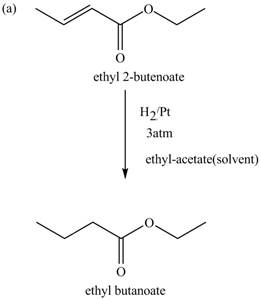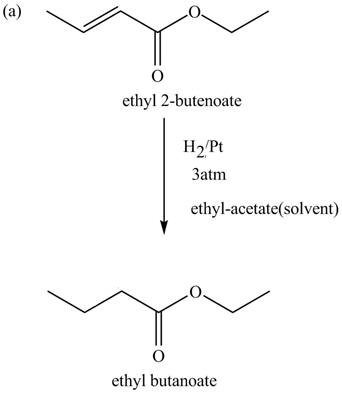
Concept explainers
(a)
Interpretation:
Preparation of
Concept-Introduction:
The carbon-carbon double bond of
Answer:
The formation of

Explanation:
Compound,

Figure 1
Conclusion:
Preparation of
(b)
Interpretation:
Preparation of
Concept Introduction:
The
Want to see the full answer?
Check out a sample textbook solution
Chapter 22 Solutions
EBK ORGANIC CHEMISTRY
- The reaction of Hbr with 2-methylpropene produces 2-bromo-2-methylpropane. What is the structure of the carbocation formed during the reaction?arrow_forwardWhich alcohols can be prepared as a single product by hydroboration– oxidation of an alkene? Which alcohols can be prepared as a single product by the acid-catalyzed addition of H2O to an alkene?arrow_forwardWhich alcohols can be prepared as a single product by hydroboration–oxidation of an alkene? Which alcohols can be prepared as a singleproduct by the acid-catalyzed addition of H2O to an alkene?arrow_forward
- 1) The acid-catalyzed dehydration of 2-methyl-2-butanol yields two alkene products, what are the names of the two alkenes? 2) which of the two alkenes is the major product?arrow_forwarda) What products would you expect from the elimination reaction of 3-Bromo-2- methylpentane? Show the reaction by writing the condensed structural formula of the reactants and products. Identify the major and minor products. b) What alkyl halide might the 3,6-Dimethyl-1- heptene have been made from?arrow_forwardA compound with formula C7H12O is treated with sodium borohydride in methanol to yield 2,2-dimethylcylopentanol. Write a reaction scheme showing the structures of the reactant, the reagents, and the product. Will the product be optically active? Explain.arrow_forward
- Which one(s) of the following reactions produce propan-1-ol? A) the alkaline hydrolysis of 1-chloropropane B) the acid hydrolysis of propyl methanoate C) the acid hydrolysis of propanenitrilearrow_forwardIn an advanced synthetic chemistry experiment, a researcher prepares a compound, ZY-7, by reacting a ketone (C5H10O) with hydroxylamine (NH2OH), followed by heating in the presence of an acid catalyst. The resulting compound, ZY-7, is then treated with a solution of sodium nitrite (NaNO2) and hydrochloric acid (HCl) at low temperature. Identify the class of compound that ZY-7 most likely belongs to after this series of reactions." A) Amide B) Oxime C) Nitro compound D) Diazonium salt E) Ester Don't use chatgpt please provide valuable answerarrow_forward1-Octen-3-ol is a potent mosquito attractant commonly used in mosquito traps. A number of reactions, including hydrogenation, will transform 1-octen-3-ol into a less effective molecule. Draw the structure of a hydrogenation product of 1-octen-3-ol.arrow_forward
- Bent (D) Trigonal pyramidal 5. A student wishes to prepare ethyl acetate from the reaction of ethanol and acetic acid. To be successful, this reaction requires (A) an acidic catalyst. (C) an oxidizing agent. (B) a basic catalyst. (D) a reducing agent. 6. Which alkyl halide reacts most rapidly with aqueous sodium hydroxide solution? (A) CH₂Cl (B) CH₂I (C) (CH3)3CCH₂Cl (D) (CH3)3CCH₂I 57. How many isomers are there with the formula C6H₁4?arrow_forward1.Name and draw the products of each reaction. (a) 3-methyl oct-2-ene + hydrochloric acid (b) 2-fluoro-2-phenyl butanoic acid + ethanol → 1arrow_forward1: Give at least five (5) uses of Etherin medicine. CH3 CH,-0-C-CH, CH, common name: methyl-t-butyl ether (MTBE) IUPAC name: 2-methoxy-2-methylpropane diphenyl ether or phenyl ether phenoxybenzene Analyze the given ether. Then describe the structural formula.arrow_forward
 Chemistry: Principles and ReactionsChemistryISBN:9781305079373Author:William L. Masterton, Cecile N. HurleyPublisher:Cengage Learning
Chemistry: Principles and ReactionsChemistryISBN:9781305079373Author:William L. Masterton, Cecile N. HurleyPublisher:Cengage Learning
